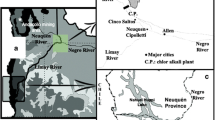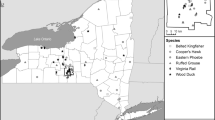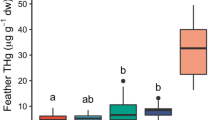Abstract
Museum specimens were used to analyze temporal trends in feather mercury (Hg) concentrations in birds collected from the state of Michigan between the years 1895 and 2007. Hg was measured in flank and secondary feathers from three species of birds that breed in the Great Lakes region; common terns (n = 32), great blue herons (n = 35), and herring gulls (n = 35). More than 90% of the Hg in feathers should be organic, but some of the heron and gull feathers collected prior to 1936 showed evidence of contamination with inorganic Hg, likely from museum preservatives. The data presented here therefore consist of organic Hg in pre-1936 samples and total Hg in post-1936 samples. Insufficient tissue was available from terns to assess organic Hg content. Mean Hg concentrations ranged from 2.9 ± 2.5 μg/g Hg in tern flank feathers to 12.4 ± 10.6 μg/g Hg in gull flank feathers. No linear trend of Hg contamination over time was detected in herons and gulls. Though a significant decrease was noted for terns, these data are presented with caution given the strong likelihood that earlier samples were preserved with inorganic mercury. When data were separated into 30-year intervals, Hg content in heron and gull feathers collected from birds sampled between 1920 and 1949 were consistently highest but not to a level of statistical significance. For example, Hg concentrations in gull secondary feathers collected in the second time interval (1920–1949) were 11.5 ± 7.8. This value was 67% higher than the first time interval (1890–1919), 44% higher than the third interval (1950–1979), and 187% higher than the fourth interval (1980–2009). Studies on Great Lakes sediments also showed greatest Hg accumulations in the mid-twentieth century. Through the use of museum specimens, these results present a unique snapshot of Hg concentrations in Great Lakes biota in the early part of the twentieth century.

Similar content being viewed by others
References
Appelquist H, Asbirk S, Drabaek I (1984) Mercury monitoring—mercury stability in bird feathers. Mar Pollut Bull 15:22–24
Appelquist H, Drabaek I, Asbirk S (1985) Variation in mercury content of guillemot feathers over 150 years. Mar Pollut Bull 16:244–248
Basu N, Scheuhammer AM, Bursian SJ, Elliott J, Rouvinen-Watt K, Chan HM (2007) Mink as a sentinel species in environmental health. Environ Res 103:130–144
Bhavsar SP, Gewurtz SB, McGoldrick DJ, Keir MJ, Backus SM (2010) Changes in mercury levels in great lakes fish between 1970s and 2007. Environ Sci Technol 44:3273–3279
Blokpoel H, Morris RD, Tessier GD (1984) Field investigations of the biology of common terns wintering in Trinidad. J Field Ornithol 55:424–434
Braune BM (1987) Comparison of total mercury levels in relation to diet and molt for nine species of marine birds. Arch Environ Contam Toxicol 16:217–224
Braune BM, Gaskin DE (1987) Mercury levels in bonapartes gulls (Larus-Philadelphia) during autumn molt in the quoddy region, New-Brunswick, Canada. Arch Environ Contam Toxicol 16:539–549
Butler R (1992) Great blue heron (Ardea herodias), the birds of North America online In: Poole A (ed) Ithaca: cornell lab of ornithology, Retrieved from the birds of North America. Available online: http://bna.birds.cornell.edu.proxy.lib.umich.edu/bna/species/025
Dietz R, Riget FF, Boertmann D, Sonne C, Olsen MT, Fjeldsa J, Falk K, Kirkegaard M, Egevang C, Asmund G, Wille F, Moller S (2006) Time trends of mercury in feathers of West Greenland birds of prey during 1851–2003. Environ Sci Technol 40:5911–5916
Dietz R, Outridge PM, Hobson KA (2009) Anthropogenic contributions to mercury levels in present-day Arctic animals—a review. Sci Total Environ 407:6120–6131
Dietz R, Born EW, Riget F, Sonne C, Aubail A, Drimmie R, Basu N (2011) Temporal trends and future predictions of mercury concentrations in Northwest Greenland polar bear (Ursus maritimus) hair. Environ Sci Technol 45:1458–1465
Evers DC, Burgess NM, Champoux L, Hoskins B, Major A, Goodale WM, Taylor RJ, Poppenga R, Daigle T (2005) Patterns and interpretation of mercury exposure in freshwater avian communities in northeastern North America. Ecotoxicology 14:193–221
Frederick PC, Hylton B, Heath JA, Spalding MG (2004) A historical record of mercury contamination in southern Florida (USA) as inferred from avian feather tissue. Environ Toxicol Chem 23:1474–1478
French TD, Campbell LM, Jackson DA, Casselman JM, Scheider WA, Hayton A (2006) Long-term changes in legacy trace organic contaminants and mercury in Lake Ontario salmon in relation to source controls, trophodynamics, and climatic variability. Limnol Oceanogr 51:2794–2807
Furness RW, Muirhead SJ, Woodburn M (1986) Using bird feathers to measure mercury in the environment—relationships between mercury content and molt. Mar Pollut Bull 17:27–30
Hebert CE, Shutt JL, Hobson KA, Weseloh DVC (1999a) Spatial and temporal differences in the diet of Great Lakes herring gulls (Larus argentatus): evidence from stable isotope analysis. Can J Fish Aquat Sci 56:323–338
Hebert CE, Norstrom RJ, Weseloh CDV (1999b) A quarter century of environmental surveillance: the Canadian Wildlife Service’s Great Lakes Herring Gull Monitoring Program. Environ Rev 7:147–166
Hebert CE, Hobson KA, Shutt JL (2000) Changes in food web structure affect rate of PCB decline in herring gull (Larus argentatus) eggs. Environ Sci Technol 34:1609–1614
Honda K, Nasu T, Tatsukawa R (1986) Seasonal canges in mercury accumulation in the black-eared kite, Milvus migrans lineatus. Environ Pollut Ser A-Ecol Biol 42:325–334
Koster MD, Ryckman DP, Weseloh DV, Struger J (1996) Mercury levels in Great Lakes herring gull (Larus argentatus) eggs, 1972–1992. Environ Pollut 93:261–270
Marvin C, Painter S, Rossmann R (2004) Spatial and temporal patterns in mercury contamination in sediments of the Laurentian Great Lakes. Environ Res 95:351–362
Monson BA (2009) Trend reversal of mercury concentrations in piscivorous fish from Minnesota Lakes: 1982–2006. Environ Sci Technol 43:1750–1755
Nam DH, Basu N (2011) Rapid methods to detect organic mercury and total selenium in biological samples. Chem Central J 5:3
Nisbet IC (2002) Common tern (Sterna hirundo), the Birds of North America Online In: A. Poole (ed.). Ithaca: cornell lab of ornithology, Retrieved from the Birds of North America Online: http://bna.birds.cornell.edu.proxy.lib.umich.edu/bna/species/618
Nriagu JO (1994) Mercury pollution from the past mining of gold and silver in the America. Sci Total Environ 149:167–181
Pirrone N, Allegrini I, Keeler GJ, Nriagu JO, Rossmann R, Robbins JA (1998) Historical atmospheric mercury emissions and depositions in North America compared to mercury accumulations in sedimentary records. Atmos Environ 32:929–940
Rossmann R (2010) Protocol to reconstruct historical contaminant loading to large lakes: the Lake Michigan sediment record of mercury. Environ Sci Technol 44:935–940
Rutkiewicz J, Scheuhammer A, Crump D, Jagla M, Basu N (2010) Investigation of spatial trends and neurochemical impacts of mercury in herring gulls across the Laurentian Great Lakes. Environ Pollut 158:2733–2737
Sandheinrich MB, Wiener JG (2011) Methylmercury in fish—advances in assessing toxicity of environmentally relevant exposures. In: Beyer WN, Meador JP (eds) Environmental contaminants in biota: interpreting tissue concentrations, 2nd edn. CRC Press/Taylor and Francis, Boca Raton
Scheuhammer AM, Meyer MW, Sandheinrich MB, Murray MW (2007) Effects of environmental methylmercury on the health of wild birds, mammals, and fish. Ambio 36:12–18
Thompson DR, Furness RW (1989) Comparison of the levels of total and organic mercury in seabird feathers. Mar Pollut Bull 20:577–579
Thompson DR, Furness RW, Walsh PM (1992) Historical changes in mercury concentrations in the marine ecosystem of the North and North-East Atlantic-Ocean as indicated by seabird Feathers. J Appl Ecol 29:79–84
Weseloh DVC, Moore DJ, Hebert CE, de Solla SR, Braune BM, McGoldrick D (2011) Current concentrations and spatial and temporal trends in mercury in Great Lakes Herring gull eggs, 1974–2009. Ecotoxicology, submitted (this issue)
Acknowledgments
We thank Dong-Ha Nam, Krittika Mittal, and Ashley Maiuri for technical assistance. We also thank two anonymous reviewers for stressing the importance of considering that archived museum specimens may be preserved with inorganic mercury. This study was funded by the University of Michigan’s Undergraduate Research Opportunities Program (UROP) and the University of Michigan School of Public Health.
Conflict of interest
No conflict of interest is declared
Author information
Authors and Affiliations
Corresponding author
Rights and permissions
About this article
Cite this article
Head, J.A., DeBofsky, A., Hinshaw, J. et al. Retrospective analysis of mercury content in feathers of birds collected from the state of Michigan (1895–2007). Ecotoxicology 20, 1636–1643 (2011). https://doi.org/10.1007/s10646-011-0738-6
Accepted:
Published:
Issue Date:
DOI: https://doi.org/10.1007/s10646-011-0738-6




